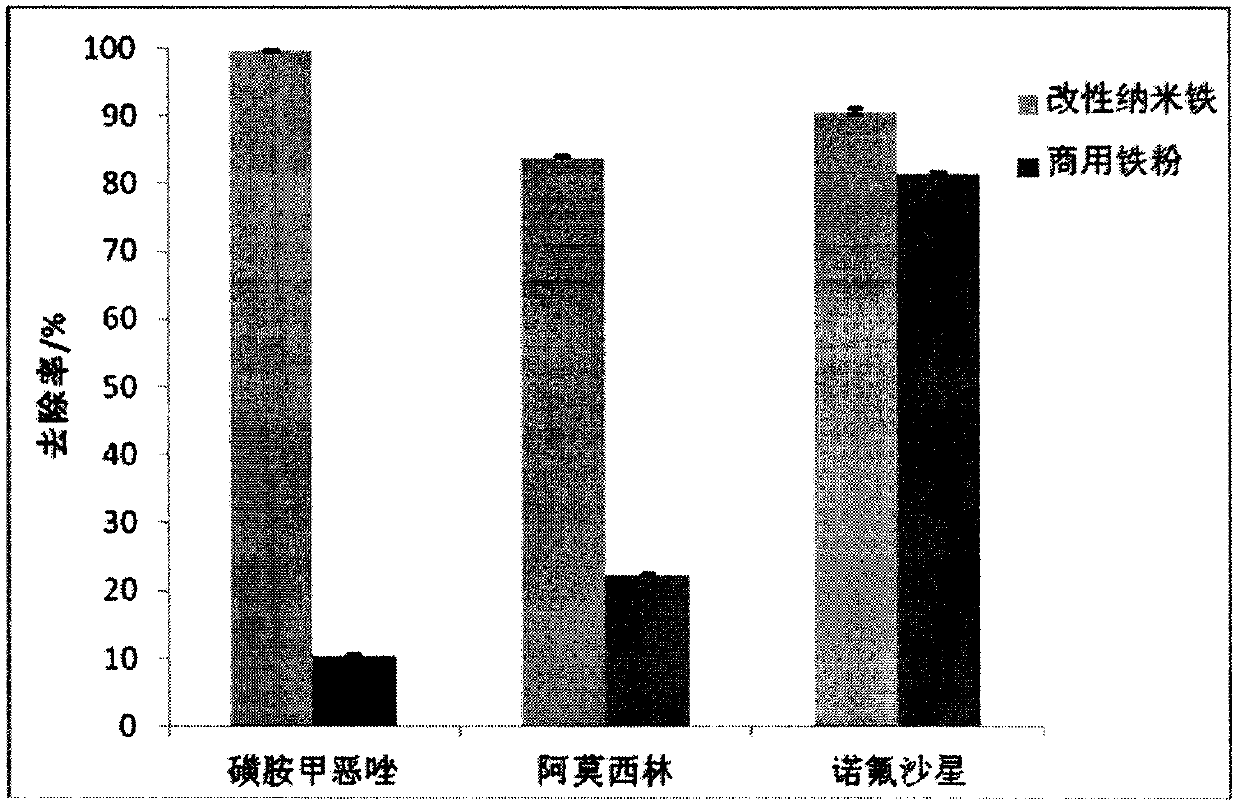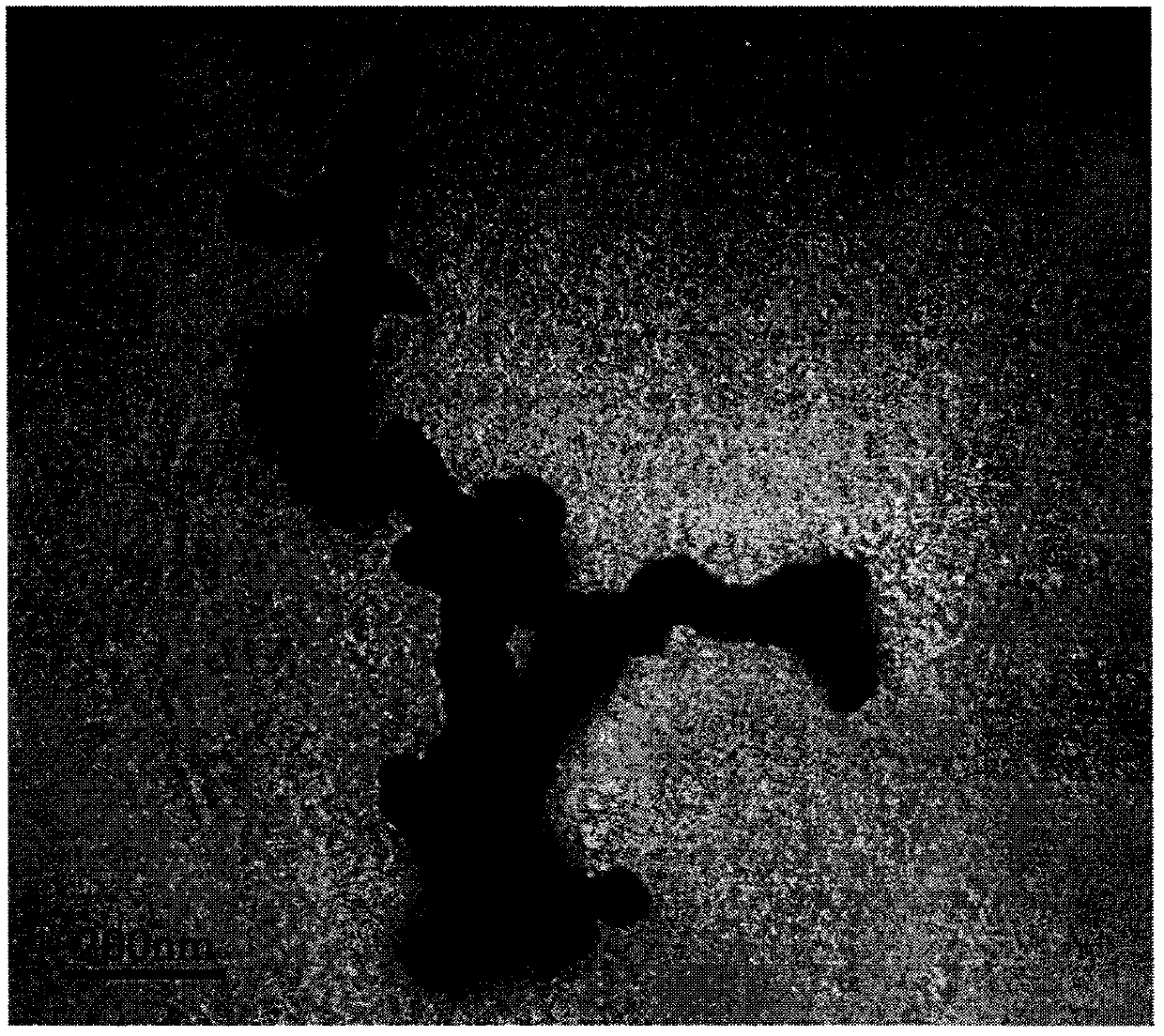Preparation of modified nano-iron and application of modified nano-iron in antibiotic drug manufacture wastewater treatment
A technology of pharmaceutical wastewater and nano-iron, applied in natural water treatment, water/sewage treatment, special compound water treatment, etc., can solve problems such as easy to produce agglomeration, and achieve the effect of high reducing activity, efficient degradation and low energy consumption
- Summary
- Abstract
- Description
- Claims
- Application Information
AI Technical Summary
Problems solved by technology
Method used
Image
Examples
Embodiment 1
[0023] The preparation of modified nano-iron and its application in the treatment of antibiotic pharmaceutical wastewater include the following steps: under the protection of nitrogen, adding ferrous salt to ethanol aqueous solution (ethanol: water = 3:7-1:9) for surface modification Add the aqueous solution of alkali containing borohydride to the above mixture drop by drop. After the dropwise addition, continue the reaction at 15°C-35°C for 20-30min to obtain a black solid precipitation;
[0024] (2) Filter the obtained black precipitate in a 0.22 μm filter membrane, wash with deionized water and ethanol 2-3 times, centrifuge (1500-3500r / min) for 10-15min, and use a magnetic material to separate . The separated black solid is precipitated at a temperature of 20°C-60°C and vacuum-dried for 12h-48h to obtain the modified nano-iron.
Embodiment 2
[0026] The modified nano-iron in Example 1 was used for the treatment of sulfamethoxazole pharmaceutical wastewater.
[0027] The modified nano-iron in Example 1 was used for the treatment of amoxicillin pharmaceutical wastewater.
[0028] The modified nano-iron in Example 1 was used for norfloxacin pharmaceutical wastewater treatment.
[0029] The present invention selects sulfamethoxazole, amoxicillin, norfloxacin polluted wastewater as pharmaceutical wastewater evaluation index, because antibiotic wastewater such as these three kinds of drugs sulfamethoxazole, amoxicillin, norfloxacin contains a large amount of refractory organic matter , the residues in the water have a strong inhibitory effect on organisms, and if they exist in the water environment for a long time, they will pose a huge threat to the ecological environment. How to quickly and effectively degrade antibiotic drugs in wastewater is of great significance to the treatment of pharmaceutical wastewater.
Embodiment 3
[0031] Modified nano-iron is used in the treatment of antibiotic pharmaceutical wastewater, and the reduction activity evaluation test is used, as shown in the following steps:
[0032] (1) Composition of simulated antibiotic pharmaceutical wastewater: Wastewater: 100ml; sulfamethoxazole concentration 10mg / L.
[0033] Activity evaluation method: In the above-mentioned simulated sulfamethoxazole pharmaceutical wastewater, add 0.08g of modified nano-iron prepared in Example 1, after reacting for 1.0h, use a centrifuge to centrifuge the solution after reaction at a speed of 3000r / min for 10min, and After vacuum ultrafiltration with a 0.22 μm organic filter membrane, the filtrate was collected for testing.
[0034] (2) Composition of simulated antibiotic pharmaceutical wastewater: Wastewater: 100ml; the concentration of amoxicillin is 10mg / L.
[0035] Activity evaluation method: Add 0.14 g of modified nano-iron in Example 1 to the above-mentioned simulated amoxicillin drug wastew...
PUM
| Property | Measurement | Unit |
|---|---|---|
| particle diameter | aaaaa | aaaaa |
| particle size | aaaaa | aaaaa |
Abstract
Description
Claims
Application Information
 Login to View More
Login to View More - R&D
- Intellectual Property
- Life Sciences
- Materials
- Tech Scout
- Unparalleled Data Quality
- Higher Quality Content
- 60% Fewer Hallucinations
Browse by: Latest US Patents, China's latest patents, Technical Efficacy Thesaurus, Application Domain, Technology Topic, Popular Technical Reports.
© 2025 PatSnap. All rights reserved.Legal|Privacy policy|Modern Slavery Act Transparency Statement|Sitemap|About US| Contact US: help@patsnap.com


